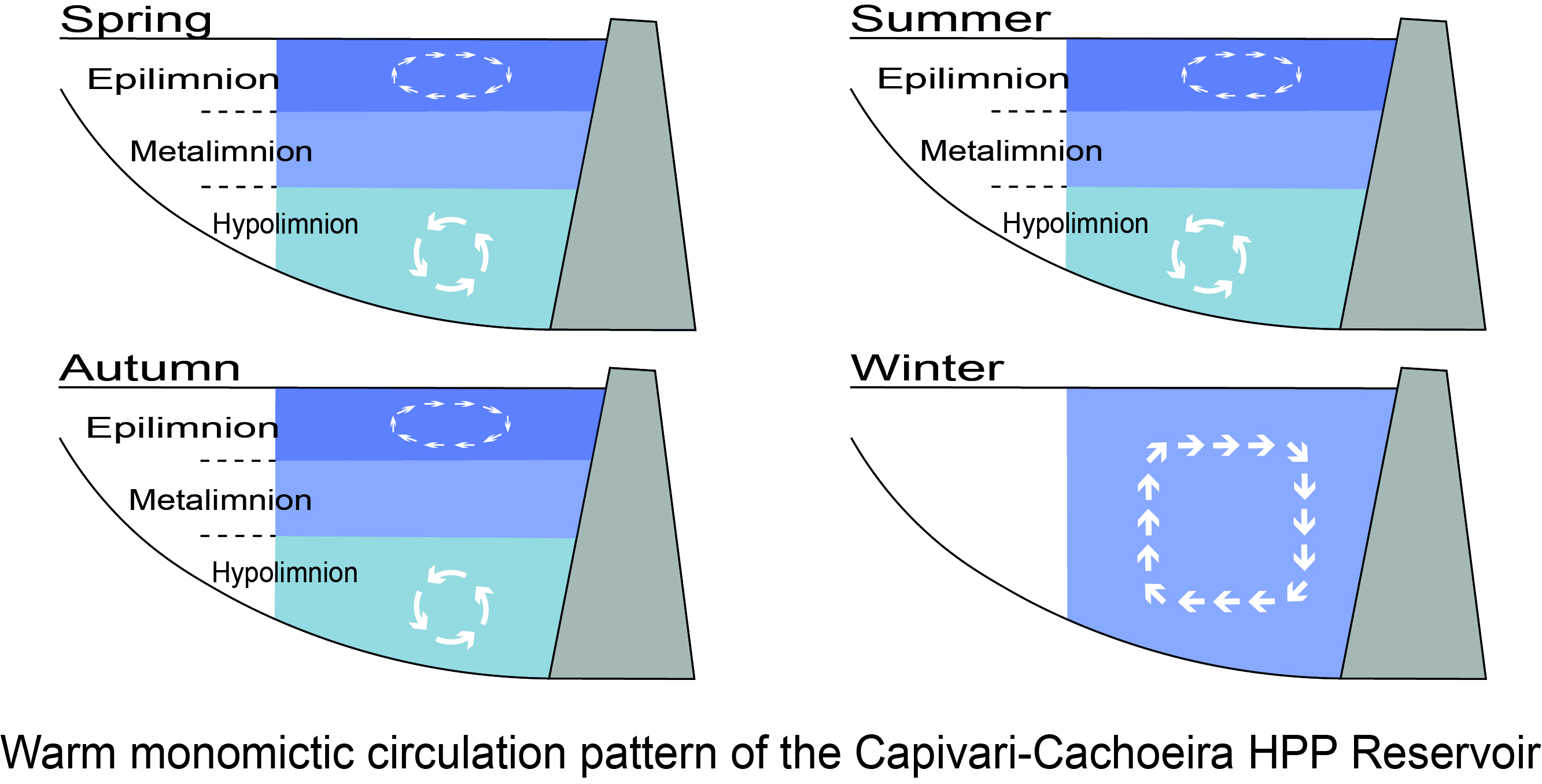Abstract
The study of the stratification processes in reservoirs is important because they happen along with several physical and chemical changes in the water, as in the distribution of dissolved gases and nutrients. The aim of this work was to study the stratification process of the Capivari-Waterfall Hydroelectric Power Plant, based on the data of the vertical profiles of dissolved oxygen and temperature, as well as the comparison of them with the calculation of Froude's Densimetric Number, and reservoir residence time. The data used are part of the self-monitoring program carried out by COPEL. These data were collected quarterly between 2005 and 2016. The hydraulic and operational data from the reservoir were used to calculations. According to the measurements of dissolved oxygen and temperature, it was considered to be stratified during almost all the year, with a trend of circulation in the colder months, this behavior characterizes lakes with warm monomictic circulation pattern. Therefore, the result of Froude's Densimetric Number, corresponded correctly with the observed. Regarding the residence time, this was not consistent with the results obtained, from the models. The use of different methodologies in evaluating circulation in reservoirs should be used in order to make the best management decision.References
Esteves, F. A., Fundamentos de Limnologia, Rio de Janeiro: Interciência, 3rd ed., 2011, ch9.
Tundisi, J. G., Tundisi, T. M. Limnologia. São Paulo: Oficina de Textos, 1rd ed., 2008, ch4.
Padial, P.R., Pompêo, M., Moschini‑Carlos, V. Heterogeneidade espacial e temporal da qualidade da água do reservatório Rio das Pedras (Complexo Billings, São Paulo). Revista Ambiente & Água, 4 (3) (2009) 35-53.
Benetti, A. D., Tucci, C. E. M. Uso de indicadores para avaliação de usinas hidrelétricas em bacias hidrográficas com múltiplos aproveitamentos, Revista de gestão de água da América Latina, 3 (1) (2006) 73-83.
Miranda, T. L. G., Brassac, N. M., Prestes, E. C., Muller, I. I., Pereira, S. Estudo dos processos de estratificação em grandes reservatórios da Bacia do Rio Iguaçu. In: Simpósio Brasileiro de Recursos Hídricos, 18., (2009), Campo Grande. Anais... Campo Grande – MS: ABRH, (2009) 1-12.
Von Sperling, E. Estudo sobre influência na qualidade da água decorrente da implantação da barragem de Santo Hipólito, Rio Das Velhas-MG. Belo Horizonte: Comitê da bacia hidrográfica do Rio das Velhas (2009) 1-28.
Elçi, Ş. Effects of thermal stratification and mixing on reservoir water quality. Limnology, (9) (2008)135–142.
Lu, J.,LI, Z. Seasonal effects of thermal stratification on the water quality of deep reservoirs: A case study of Heihe Reservoir, Xi'an City. J. Lake Science. 26 (5) (2014) 698-706.
Yu, Z., Yang, J., Amalfitano, S., Yu, X., Liu, L. Effects of water stratification and mixing on microbial community structure in a subtropical deep reservoir. Scientific Reports. 25 (4) (2014) 5821.
Xiao, Y., Huang, T., Zhang, H. Effects of Seasonal Thermal Stratification on the Functional Diversity and Composition of the Microbial Community in a Drinking Water Reservoir. Water, 7 (10) (2015) 5525-5546.
Copel. Usina Parigot de Souza. (2016). Disponível em:< http://www.copel.com/hpcopel/root/nivel2.jsp?endereco=%2Fhpcopel%2Froot%2Fpagcopel2.nsf%2F044b34faa7cc1143032570bd0059aa29%2F08013ddc621f4eed03257412005ed73>. Acesso em: 01 ago. 2017.
Microsoft. Microsoft Office Excel 2013. [S.I.]: Microsoft Inc, (2013)
Tucci, C. E. M. Modelos Hidrológicos. Porto Alegre: ABRH, ed. UFRGS, 1998, ch11.
WRE, 1969. Mathematical Model for Prediction of Thermal Energy Changes in Inpoundments US EPA 16130.
Colombo, G. T., Mannich, M. Estudo da estratificação térmica do reservatório Vossoroca por meio de índices físicos. . In: Simpósio Brasileiro de Recursos Hídricos, 22., (2017), Florianópolis. Anais... Florianópolis – SC: ABRH, (2017) 1-8.
Ferreira, D. M., Cunha, C. Simulação numérica do comportamento térmico do reservatório do Rio Verde. Eng Sanit Ambient, 18 (1) (2013) 83-93.
Lactec – Instituto de Tecnologia para o Desenvolvimento. Relatório Anual do Automonitoramento da Qualidade das Águas Superficiais do Rio Capivari, na região da Usina Governador Pedro Viriato Parigot De Souza (UHE Capivari-Cachoeira), Curitiba: Lactec, (2015) 41.

This work is licensed under a Creative Commons Attribution 4.0 International License.
Copyright (c) 2018 Eclética Química Journal




